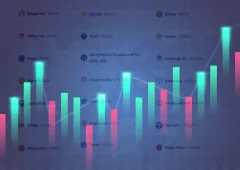Bitcoin Price Peak Predicted for September 2025, According This Indicator
08.01.2025 20:00 2 min. read Kosta Gushterov
Bitcoin continues to dominate the cryptocurrency market, with its performance often serving as a barometer for the overall industry.
While BTC is currently experiencing a correction, an important indicator suggests that the peak of its cycle is approaching. Let’s dive into the insights provided by this indicator and explore when BTC might reach its price top.
The Pi Cycle Indicator is known for its remarkable accuracy in predicting Bitcoin’s price peaks, having successfully forecasted the tops in 2013, 2017, and 2021. Based on the intersection of the 111-day moving average and the 350-day moving average (doubled), this tool signals when the market is nearing its peak.
Despite Bitcoin’s current struggles during the ongoing market downturn, the Pi Cycle Indicator suggests that the price top could form sometime in mid-to-late 2025. While the timing might shift slightly, historical patterns show that the top often aligns closely with this prediction.
According to the latest analysis, the next predicted Bitcoin price top will occur on September 17, 2025. This forecast is based on the Pi Cycle Indicator’s consistent performance, where the convergence of the 111 DMA and 350 DMAx2 has historically coincided with market peaks.
While the exact price at this time remains uncertain, some experts speculate that Bitcoin could surpass six figures, driven by factors such as continued global adoption and the political landscape, including the influence of Donald Trump’s presidency.
-
1
UniCredit to Launch Structured Product Tied to BlackRock’s Spot Bitcoin ETF
01.07.2025 17:53 1 min. read -
2
Saylor’s Strategy Halts Bitcoin Buying After Historic Accumulation
07.07.2025 17:00 2 min. read -
3
Trump’s Two big Bitcoin Moves: Key Catalysts or Just Noise for BTC Price?
08.07.2025 7:30 2 min. read -
4
Bitcoin Market Stalls as Profit-Taking, Whale Dispersal, and Sideways Action Define the Cycle
01.07.2025 20:00 3 min. read -
5
Speculation Surges as Binance BTC Futures Volume Tops $650 Trillion
04.07.2025 17:37 2 min. read
Public Companies Now hold Over $100 Billion in Bitcoin — 4% of Total Supply
According to new data shared by Bitcoin Magazine Pro, publicly traded companies now collectively hold over 844,822 BTC, valued at more than $100.5 billion, marking a historic milestone for institutional Bitcoin adoption.
Trump Media Holds $2B in Bitcoin as Crypto Plan Expands
Trump Media and Technology Group, the parent company of Truth Social, Truth+, and Truth.Fi, has officially disclosed that it now holds approximately $2 billion in Bitcoin and Bitcoin-related securities.
Strategy Adds 6,220 BTC, Pushing Total Holdings Past 607,000
Michael Saylor’s Strategy has confirmed another major Bitcoin purchase, acquiring 6,220 BTC last week for approximately $739.8 million.
Bitcoin Open Interest Hits $42B as Funding Rates Signal Bullish Overextension
Bitcoin’s derivatives market is heating up, with open interest climbing back to $42 billion while funding rates continue to surge.
-
1
UniCredit to Launch Structured Product Tied to BlackRock’s Spot Bitcoin ETF
01.07.2025 17:53 1 min. read -
2
Saylor’s Strategy Halts Bitcoin Buying After Historic Accumulation
07.07.2025 17:00 2 min. read -
3
Trump’s Two big Bitcoin Moves: Key Catalysts or Just Noise for BTC Price?
08.07.2025 7:30 2 min. read -
4
Bitcoin Market Stalls as Profit-Taking, Whale Dispersal, and Sideways Action Define the Cycle
01.07.2025 20:00 3 min. read -
5
Speculation Surges as Binance BTC Futures Volume Tops $650 Trillion
04.07.2025 17:37 2 min. read


